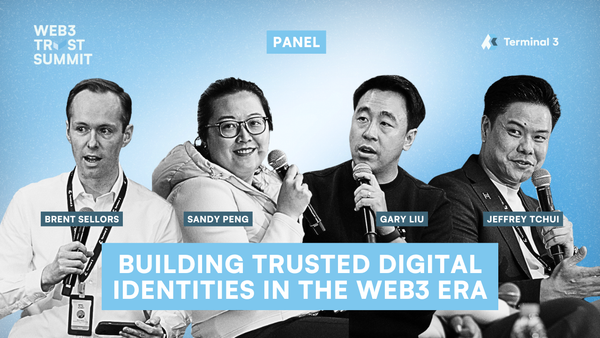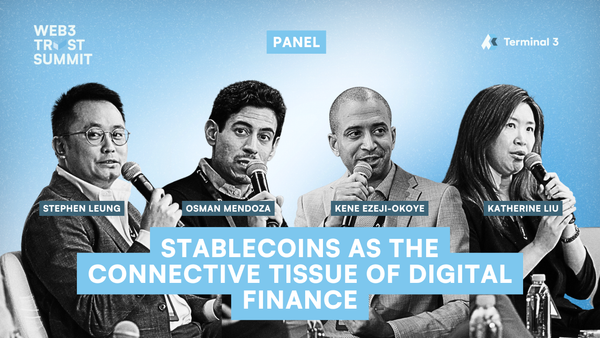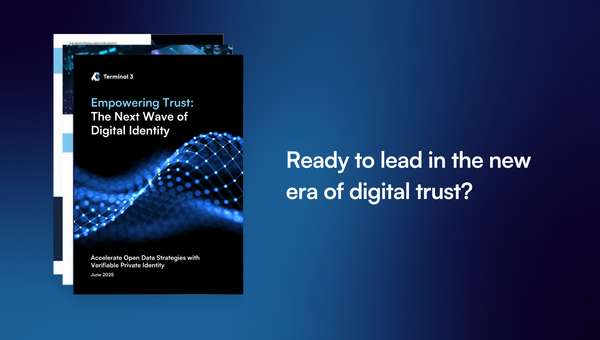Token2049: a Web3 carnival with 20K people and Ethereum-Solana showdown

This is probably the most important Web3 event in the world
GM,
It’s been a busy couple of weeks and we apologize for our absence. But we are back and recovered after a major week in Singapore.
We returned to Token 2049 in the country known as Little Red Dot. Last year, it was big—but it was even bigger this year. The organizers boasted 20,000 attendees, more than 400 exhibitors and over 700 side events across the week. In short, this is the largest and most important Web3 event in Asia, if not the world.
Here is our take on what you missed if you weren’t there.
Best,
What’s going on?
Against the odds, the organizers of Token2049 managed to make this year’s event bigger than ever.
In true Web3 fashion, Token2049 wasn’t just one event. It sparked a carnival of single-day gatherings and evening parties, offering endless opportunities for networking, business deals, and, of course, indulging in some lavish decadence.
Token2049 Singapore this year included appearances from top DJs, rooftop parties at prestigious hotels like Marina Bay Sands, the Formula One Grand Prix, Solana Breakpoint, the Networked State Conference, and much more. The show itself featured massage rooms, a climbing wall, pickleball courts, boxing punch bags, martial arts fights and much more.
Digging beyond the flamboyant touches, here’s what we took away from the week-long extravaganza.
SO WHAT?
1. The world’s top Web3 show
Token2049 is now the most important Web3 show on the planet.
Tickets to the show itself aren’t cheap, retailing for around $1,000, so to fill an event with 20,000 attendees is impressive. But that’s really only the half of it—tens of thousands make their way over to Singapore just for the rich array of side events that run concurrent to Token2049 and don’t require a ticket.
According to the official list maintained by Token2049 organizers, there were 800 side events this week.
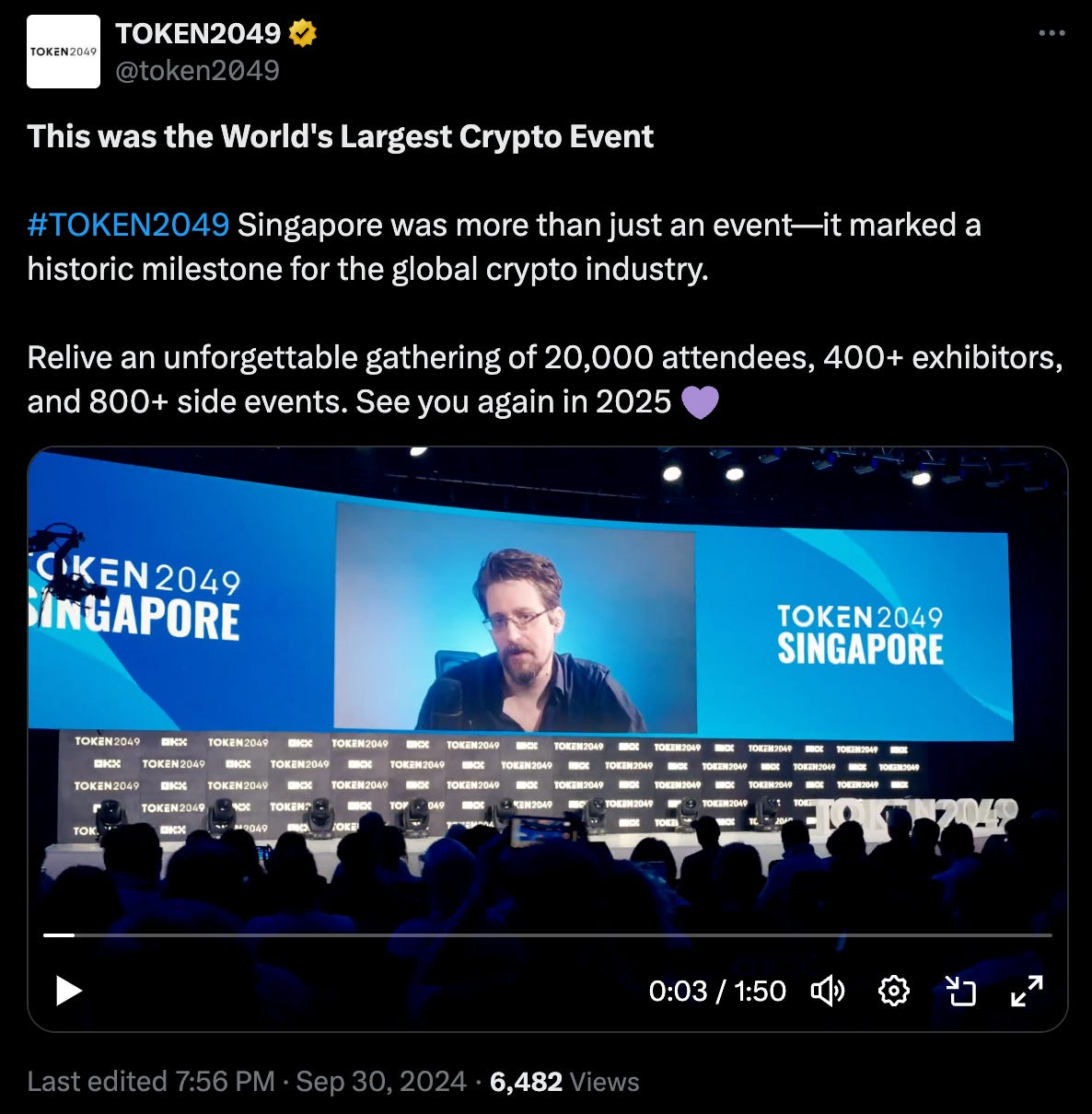
That means that without even attending Token2049, you can network and arrange meetings with the tens of thousands who are in Singapore that week.
This year, however, the overall circus around Token2049 kicked up a notch beyond last year, which was itself huge. This year, attendees came from all over the world: including the US, Europe and Middle East as well as the usual Asian representation.
The crowd also felt more encompassing than before: from infrastructure, to developers, traditional finance, investors and more.
As for the parties, they featured top DJs like Diplo, Don Diablo, Matt Steffanina, and Steve Aoki, all thanks to deep-pocketed hosts such as Mysten Labs (behind Sui), AI platform Gaia, Tron, and others.

It’s hard to imagine that there’s any event that can compete in terms of global and ecosystem involvement.
Mainnet, the New York-based event from Web3 analysis firm Messari, took place this week and, based on anecdotal feedback from friends of SO WHAT, it was impressive but it didn’t land a glove on Token2049.
It isn’t all sunshine and roses, however. It was easy to feel daunted by the sheer scope of events at Token2049 week. The organizers are hugely ambitious and may look to increase the share of the show in 2025—but bigger doesn’t always mean better and they may have already reached optimum size.
A bigger challenge may be raising the significance of their two other annual events in Dubai and London, which have been smaller and less heralded than Singapore.
2. Ethereum vs Solana
Ethereum has long been the spiritual creator of Web3. The Bitcoin whitepaper ushered in the era, but it was the creation of Ethereum that turned crypto from a digital asset into an ecosystem with services, decentralized apps and more. While Ethereum may have been the instigator, it is far from the only developer-focused Web3 ecosystem—Solana has long made a claim, and this year it was pressed harder than ever.
Kyle Samani, a co-founder of investment firm Multicoin Capital, was among those to speak directly about Solana’s opportunity to become more important than Ethereum.
One of the key arguments Solana advocates make is that the ecosystem is more focused on developers than Ethereum, where the prevailing trend has been infrastructure projects and solutions to address the difficulties of scaling on Ethereum.
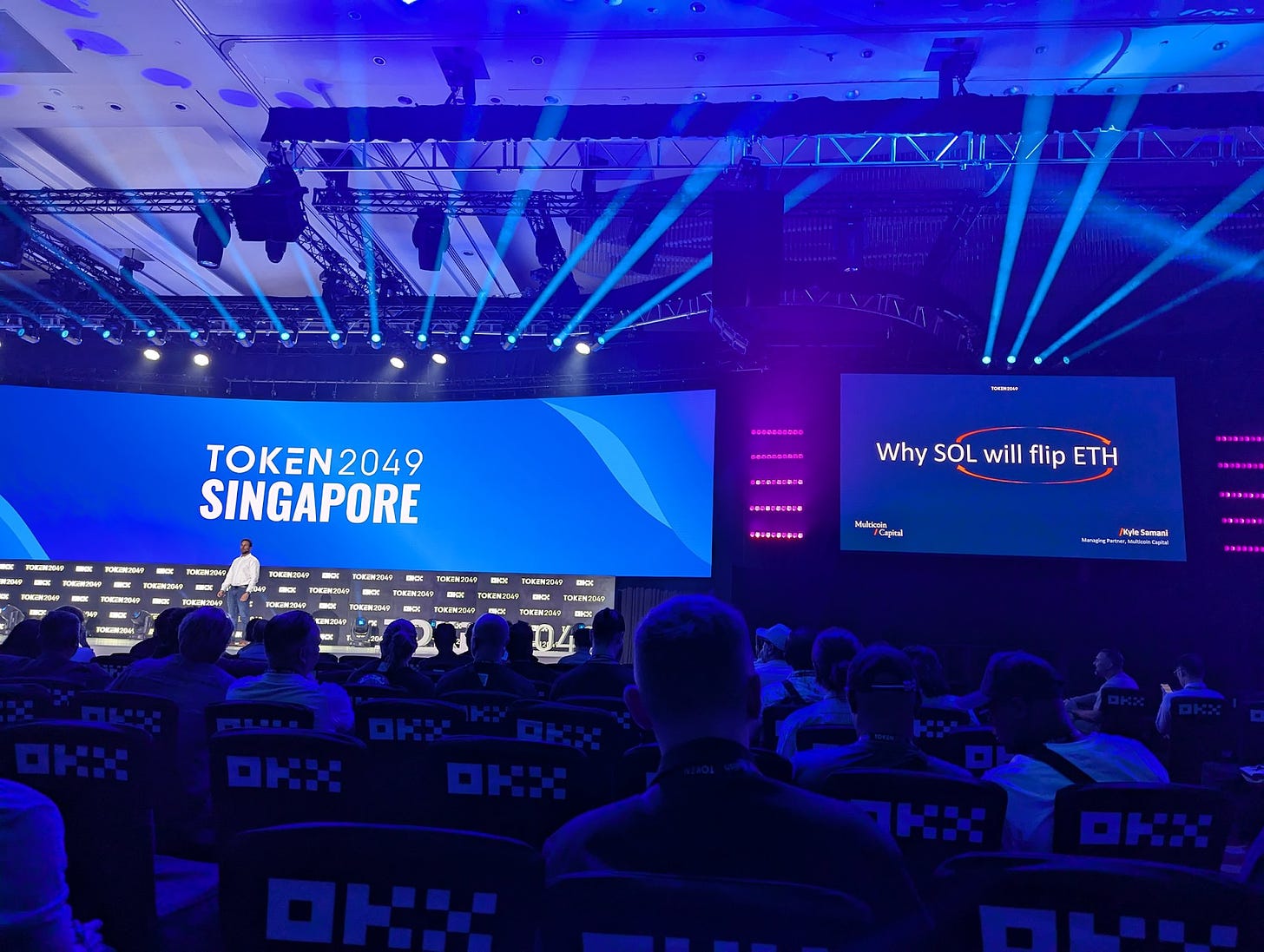
As if to make the point, the Solana Foundation arranged its Breakpoint conference in Singapore for the first time. The event started the day after Token2049 closed, taking advantage of the number of Web3 people who were in town, and it had a much stronger focus on developers and applications.
Samani argued that Ethereum has become confusing and lacks a clear roadmap, whereas Solana has always had a well-defined goal. He also claimed Solana is better suited for the rise of AI due to its structure, as it avoids the complications of Ethereum’s layer-2 scalability solutions, which siphon value away from ETH itself.
Solana has come out of a difficult period that saw it dragged through the mire following the downfall of FTX, which was closely aligned with the project. Token price isn’t the be-all and end-all, but in this case it clearly shows Solana’s recovery and renewed confidence in the project and its ecosystem.
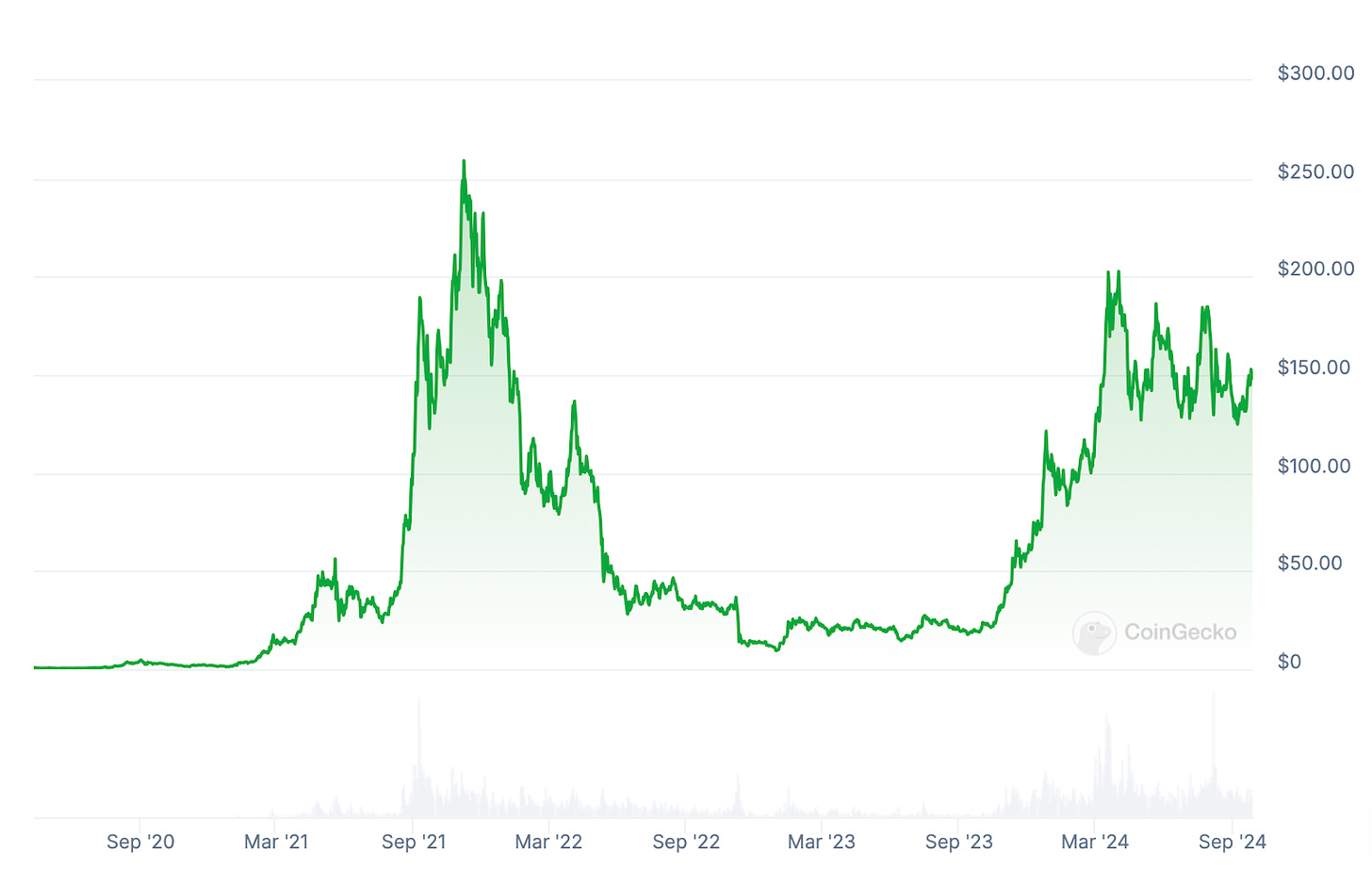
3. Crypto stays weird and anarchy remains
Ethereum co-creator Vitalik Buterin said in a speech that crypto is no longer in its infancy, but plenty of quirks from the industry remain.
There’s Buterin, for one. During his keynote, he even sang the Japanese song Castle in the Sky from a Studio Ghibli film—an unorthodox moment that drew plenty of attention and highlighted how crypto’s quirky nature endures.
Outside of Token2049 were signs crypto anarchy remains alive, even if the industry has matured. Balaji Srinivasan, the former CTO of Coinbase and once of storied VC a16z, held the inaugural Network State Conference, a show based on his book that outlays the successor to the nation state.
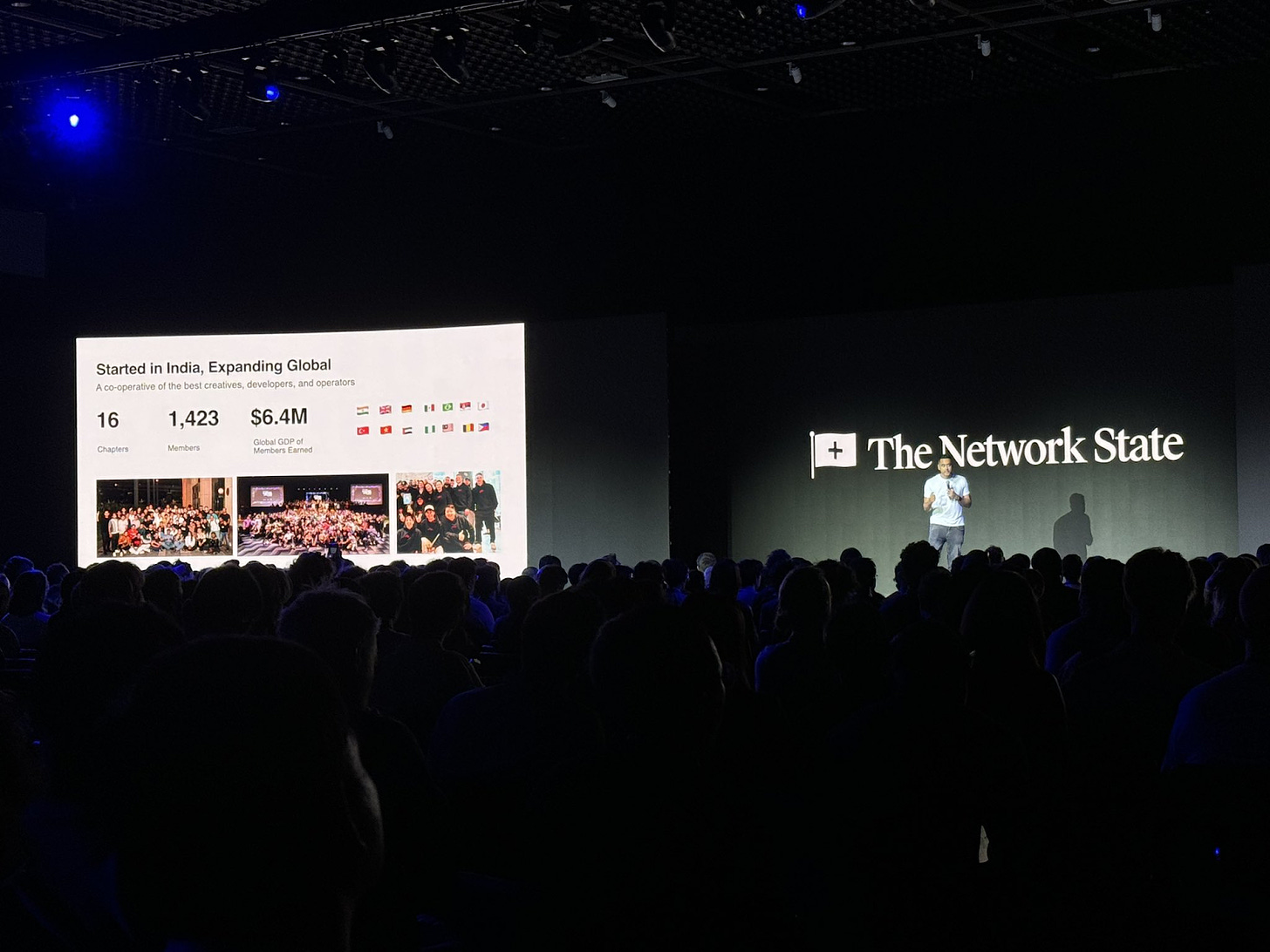
“A network state is a highly aligned online community with a capacity for collective action that crowdfunds territory around the world and eventually gains diplomatic recognition from pre-existing states,” Srinivasan writes on his website.
The concept is tightly aligned with Web3 and its core concepts of decentralization, freedom from national government policy and democratization of information. The conference took the concept to a new level, but it is poised to move even further forward with The Network School, a program that Srinivasan will run for three months on an island in Southeast Asia.
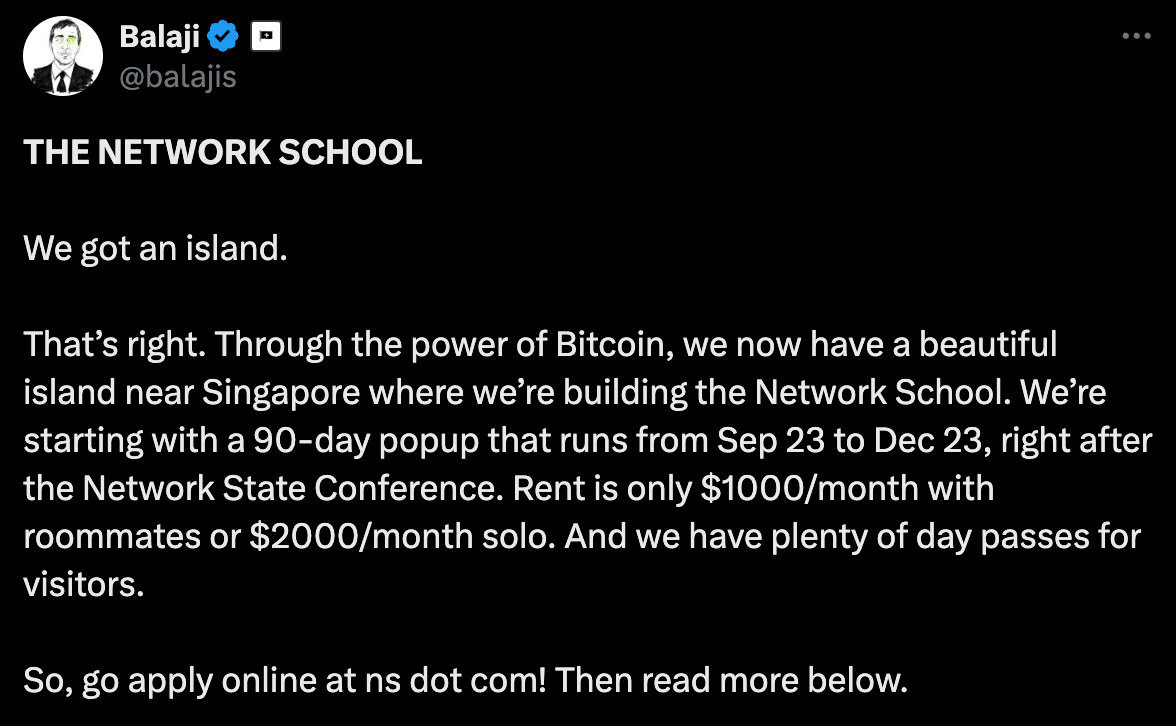
The goal, Srinivasan said, is to give opportunities for talent to rise:
As motivation, I’ve always wanted to expand equality of opportunity around the world. Because my father was born in a desperately poor country, but with the right opportunity he was able to make something of himself. Like dark matter, he was dark talent. And for more than a decade I’ve been thinking about how to give others who are similarly situated the chance to make something of themselves. That is: I’ve been thinking about how to empower the dark talent of the world.
US universities used to fill this role, even imperfectly, and I loved Stanford when I taught there years ago. But the data shows they’ve declined in recent days. And they’re just not affordable or accessible to most of the world. So, it’s time for a new approach. And thanks to Saraswati and Satoshi, I have the resources to endow a new Internet-first institution: the Network School.
Aligning the conference with Token2049 and Solana Breakpoint was a smart move, and many attendees we spoke with stayed in Singapore specifically for the show.
News bytes
Coindesk has a major story looking at how North Korea has placed its citizens in dozens of top Web3 companies, bringing security and information risks to the industry—we wrote about how and why North Korea targets Web3 in this post from August
Aptos, a blockchain started by former Facebook employees, is doubling down on Japan after it acquired local blockchain network Palette Chain—Japan has seen corporate adoption of Web3 and has a more pro-crypto government in place
Binance now has a license in Argentina, which becomes the 20th market where it is regulated
In other news, former Binance CEO Changpeng Zhao was released from jail, he served four months after pleading guilty to charges of money laundering—he plans to work on a Web3 educational project that he announced last year
The SEC is appealing a judgment which ruled that some sales of Ripple’s XRP token did not violate securities laws
Meanwhile the first application for an XRP ETF is in after Bitwise, which manages $4.5 billion in assets, put forward a submission
That’s all for this week!
Share your feedback, questions or requests via email to: sowhat@terminal3.io

